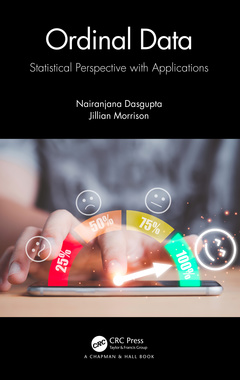Ordinal Data Analysis Statistical Perspective with Applications
Auteurs : Dasgupta Nairanjana, Morrison Jillian

This book is a step-by-step data story for analyzing ordinal data from start to finish. The book is for researchers, statisticians and scientists who are working with datasets where the response is ordinal. This type of data is common in many disciplines, not just in surveys (as is often thought). For example, in the biological sciences, there is an interest in understanding and predicting the (growth) stage (of a plant or animal) based on a multitude of factors. Likewise, ordinal data is common in environmental sciences (for example, stage of a storm), chemical sciences (for example, type of reaction), physical sciences (for example, stage of damage when force is applied), medical sciences (for example, degree of pain) and social sciences (for example, demographic factors like social status categorized in brackets). There has been no complete text about how to model an ordinal response as a function of multiple numerical and categorical predictors. There has always been a reluctance and reticence towards ordinal data as it lies in a no-man?s land between numerical and categorical data.
Examples from health sciences are used to illustrate in detail the process of how to analyze ordinal data, from exploratory analysis to modeling, to inference and diagnostics. This book also shows how Likert-type analysis is often used incorrectly and discusses the reason behind it. Similarly, it discusses the methods related to Structural Equations and talks about appropriate uses of this class of methods.
The text is meant to serve as a reference book and to be a ?how-to? resource along with the ?why? and ?when? for modeling ordinal data.
Key Features:
- Includes applications of the statistical theory
- Includes illustrated examples with the associated R and SAS code
- Discusses the key differences between the different methods that are used for ordinal data analysis
- Bridges the gap between methods for ordinal data analysis used in different disciplines
Part 1: Introduction to Ordinal Data 1. Ordinal Data Part 2: Exploratory Analysis 2. Summarizing Ordinal Data Part 3: Methods for the Analysis of Ordinal Data 3. Historical Perspective 4. Likert Scale 5. Cumulative Distribution Function (CDF) Models 6. Latent Variable Models: Structural Equation Models Part 4: Further Work with Ordinal Data 7. Diagnostics of the Ordinal Regression Models 8. Simulating Ordinal Models Part 5: Overall Summary 9. Data Story: Analysis of the Heart Data 10. Tying up Loose Ends and Overall Summary
Nairanjana (aka “Jan”) Dasgupta is a Regents Professor and Boeing Distinguished Professor of Math and Science Education at Washington State University. She also serves as the Professor of Statistics and Director of the Data Analytics Program. She is a Fellow of ASA and an inductee in the WA State Academy of Sciences. She is passionate about the understandability and applicability of statistical methods in real-life applications.
Jillian Morrison is Assistant Professor of Statistical and Data Sciences at The College of Wooster. She serves as Chair of the Communications Committee and a member of the governing council for the Caucus for Women in Statistics and Data Science. She is also a fellow of the Mathematical Association of America’s Project NExT. Her work focuses on applying statistical and data science methods to solve problems in the real world.
Date de parution : 06-2024
15.6x23.4 cm



